|

Reference Guide
|
|
Paper Handling
Loading Special Paper
 Multipart forms
Multipart forms
 Overlapping multipart forms
Overlapping multipart forms
 Labels
Labels
 Continuous forms with labels
Continuous forms with labels
 Overlapping multipart forms with labels
Overlapping multipart forms with labels
 Envelopes
Envelopes
 Postcards
Postcards
Multipart forms
Your printer can print on both single-sheet and continuous multipart forms. It can use multipart forms with up to eight parts including the original.
 |
Caution:
|
 |
Use only carbonless multipart forms.
|
Before printing, set the paper-thickness lever to the appropriate position for your multipart forms referring to the table in Adjusting the Paper-Thickness Lever.
You can load single-sheet multipart forms from the paper guide, or with the optional cut-sheet feeder or optional automatic sheet alignment unit. For instructions, see Loading Single Sheets, Loading paper to the cut-sheet feeder, or Loading paper using the automatic sheet alignment unit. You can load continuous multipart forms in the same way as you load ordinary continuous paper. For instructions, see Loading Continuous Paper.
 |
Caution:
|
 | -
When printing on multipart forms, make sure that your software settings keep the printing entirely within the printable area of the forms. Printing on the edge of a multipart form can damage the print head. For information about the printable area, see Printable area.
|
 | -
Single-sheet multipart forms that are glued at the side of the form should be loaded only from the paper guide, not from the optional cut-sheet feeder.
|

[Top]
Overlapping multipart forms
Overlapping multipart forms are a type of continuous paper with multipart forms. The page length of the multipart forms is longer than that of the backing continuous paper. So when extended, one page's multipart forms overlap the next page's multipart forms as shown below. This overlapping area is thicker than the printable area.

Follow these steps to load overlapping multipart forms:
 |
Caution:
|
 |
Use overlapping multipart forms only under normal operating conditions.
|
 |
Make sure of the following:
|
-
Your software settings keep the printing entirely within the printable area. See Printable area for more information.
-
Tractor is selected as the paper source on the control panel.
-
The setting of the page length for tractor in the default settings matches the page length of the form you use. See Changing default settings for more information.
 |
Turn on Overlapping Forms and Skip over perforation settings in the default-setting mode.
|
 |  |
Note:
|
 |  |
When Overlapping Forms is turned on in the default-setting mode, the printer automatically activates the auto paper thickness function even though the paper-thickness lever may be set to another position.
|
 |  |
Caution:
|
 |  | -
Printing on the edge of overlapping multipart forms can damage the print head.
|
 |  | -
Be sure to turn on Overlapping Forms and Skip over perforation settings in the default-setting mode when using this type of paper; otherwise your printer may be damaged.
|
To tear off and eject overlapping multipart forms
Always tear off and eject overlapping multipart forms following the instructions described below.
 |
Note:
|
 |
When Overlapping Forms is turned on in the default-setting mode, the Tear Off/Special Paper button is disabled and the Load/Eject button only feeds forms forward.
|
 |
At the back of your printer, tear off the last overlapping multipart form that has entered the printer.
|
 |
Press the LF/FF button to eject the last overlapping multipart forms forward.
|

[Top]
Labels
When selecting labels for printing, always choose labels mounted on continuous backing sheets with sprocket holes for use with a tractor. Do not use labels on shiny single-sheet backing, because the backing sheet tends to slip and may not feed properly.
Follow these steps to load labels:
 |
Caution:
|
 |
Use labels only under normal operating conditions because labels are especially sensitive to temperature and humidity.
|
 |
Make sure of the following:
|
-
Your software settings keep the printing entirely within the printable area. For information about the printable area, see Printable area.
 |  |
Caution:
|
 |  |
Printing on the edge of a label can damage the print head.
|
-
The auto tear-off function is turned off in the default-setting mode.
-
If you use labels whose backing sheet is exposed, make sure the paper-thickness lever is not set to AUTO. Set it to the appropriate position. See Adjusting the Paper-Thickness Lever for more information.
To tear off and eject labels
Always tear off and eject labels as described below.
 |
Caution:
|
 |
Never feed labels backward using the Load/Eject button, Tear Off/Special Paper button, or knob on the right side of the printer. Labels can easily peel off their backing and jam the printer.
|
 |
At the back of your printer, tear off the last label form that has entered the printer, but do not press the Tear Off/Special Paper button. See the illustration below.
|
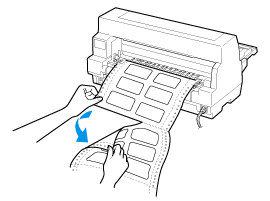
 |
Press the LF/FF button to eject the last label form forward.
|
 |
Caution:
|
 |
Do not leave labels loaded in the printer between print jobs; they tend to curl and may come off their backing sheet and jam the printer when you resume printing.
|

[Top]
Continuous forms with labels
The continuous forms with labels is a type of continuous paper with one label on each page. This is different from label paper, which consists entirely of labels. When printing on this type of paper, the printer must adjust the height of the print head for the extra thickness of the labels.
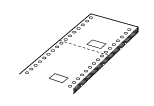
Follow these steps to load continuous forms with labels:
 |
Caution:
|
 |
Use continuous forms with labels only under normal operating conditions.
|
 |
Make sure of the following:
|
-
Your software settings keep the printing entirely within the printable area. See Printable area for more information.
-
Tractor is selected as the paper source on the control panel.
 |
Turn on Overlapping Forms and Skip over perforation settings in the default-setting mode.
|
 |  |
Note:
|
 |  |
When Overlapping Forms is turned on in the default-setting mode, the printer automatically activates the auto paper thickness function even though the paper-thickness lever may be set to another position.
|
 |
Caution:
|
 | -
Printing on the edge of continuous forms with labels can damage the print head.
|
 | -
When loading continuous forms with labels, make sure the left edge of the form is no further than 3 cm to the left of the arrow mark (when facing the back of the printer).
|
To tear off and eject continuous forms with labels
Always tear off and eject continuous forms with labels by following the procedure below.
 |
Note:
|
 |
When Overlapping Forms is turned on in the default-setting mode, the Tear Off/Special Paper button is disabled and the Load/Eject button only feeds forms forward.
|
 |
At the back of your printer, tear off the last continuous form with labels that has entered the printer.
|
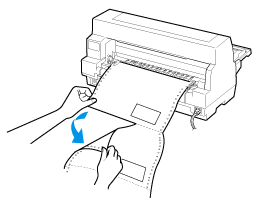
 |
Press the LF/FF button to eject the last form forward.
|
 |
To print on another type of paper, turn off Overlapping Forms and Skip over perforation settings in the default-setting mode.
|
 |
Caution:
|
 |
Do not leave continuous forms with labels loaded in the printer between print jobs; they tend to curl and may come off their backing sheet and jam the printer when you resume printing.
|

[Top]
Overlapping multipart forms with labels
This kind of continuous paper is a combination of the two types of forms; overlapping multipart forms and continuous forms with labels. Be sure to follow any special instructions intended for either type of forms.

 |
Caution:
|
 |
Use overlapping multipart forms with labels only under normal operating conditions because labels are especially sensitive to temperature and humidity.
|
Follow these steps to load overlapping multipart forms with labels:
 |
Make sure of the following:
|
-
Your software settings keep the printing entirely within the printable area. See Printable area for more information.
-
Tractor is selected as the paper source on the control panel.
-
The setting of the page length for tractor in the default settings matches the page length of the form you use. See Changing default settings for more information.
 |
Turn on Overlapping Forms and Skip over perforation settings in the default-setting mode.
|
 |  |
Note:
|
 |  |
When Overlapping Forms is turned on in the default-setting mode, the printer automatically activates the auto paper thickness function even though the paper-thickness lever may be set to another position.
|
 |
Caution:
|
 | -
Printing on the edge of overlapping multipart forms with labels can damage the print head.
|
 | -
When loading overlapping multipart forms with labels, make sure the left edge of the form is no further than 3 cm to the left of the arrow mark (when facing the back of the printer).
|
To tear off and eject overlapping multipart forms with labels
Always tear off and eject overlapping multipart forms with labels by following the procedure below.
 |
Note:
|
 |
When Overlapping Forms is turned on in the default-setting mode, the Tear Off/Special Paper button is disabled and the Load/Eject button only feeds forms forward.
|
 |
At the back of your printer, tear off the last overlapping multipart form with labels that has entered the printer.
|
 |
Press the LF/FF button to eject the last form forward.
|
 |
To print on another type of paper, turn off Overlapping Forms and Skip over perforation settings in the default-setting mode.
|
 |
Caution:
|
 |
Do not leave overlapping multipart forms with labels loaded in the printer between print jobs; they tend to curl and may come off their backing sheet and jam the printer when you resume printing.
|

[Top]
Envelopes
You can print on a variety of envelopes by loading them the same way you load single sheets — from the paper guide or with the optional cut-sheet feeder or optional automatic sheet alignment unit.
Follow these steps to load envelopes:
 |
Caution:
|
 |
Use envelopes only under normal operating conditions.
|
 |
Make sure that your software settings keep the printing entirely within the printable area. See Printable area for more information.
|
 |  |
Caution:
|
 |  |
Printing on the edge of an envelope can damage the print head.
|
 |
Make sure that Manual/CSF is selected as the paper source on the control panel. If not, select it by pressing the Paper Source button.
|
 |
Select Envelope on the control panel by pressing the Tear Off/Special Paper button.
|
from the paper guide
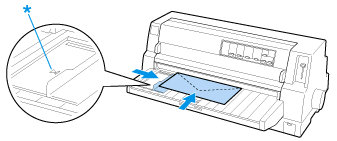
* top edge first and flap side down

[Top]
Postcards
You can print on a variety of postcards by loading them the same way you load single sheets from the paper guide or with the optional cut-sheet feeder or optional automatic sheet alignment unit.
Follow these steps to load postcards.
 |
Caution:
|
 |
Use postcards only under normal operating conditions.
|
 |
Make sure that your software settings keep the printing entirely within the printable area. See Printable area for more information.
|
 |  |
Caution:
|
 |  |
Printing on the edge of a postcard can damage the print head.
|
 |
Make sure that Manual/CSF is selected as the paper source on the control panel. If not, select it by pressing the Paper Source button.
|
 |
Select Card on the control panel by pressing the Tear Off/Special Paper button.
|
from the paper guide
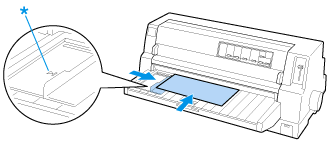
* guide mark

[Top]
| Version 1.00E, Copyright © 2002, SEIKO EPSON CORPORATION |
Multipart forms
Overlapping multipart forms
Labels
Continuous forms with labels
Overlapping multipart forms with labels
Envelopes
Postcards